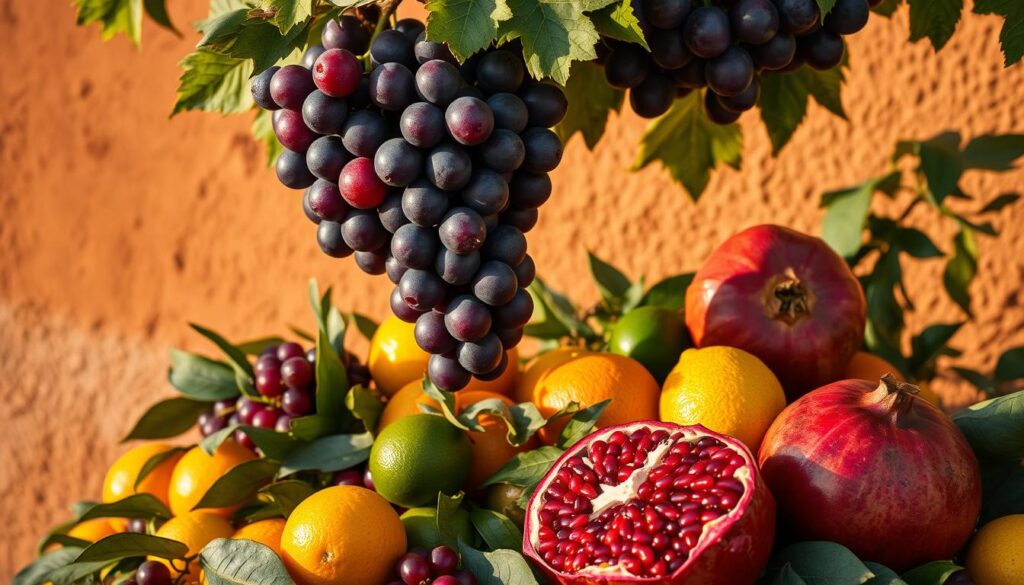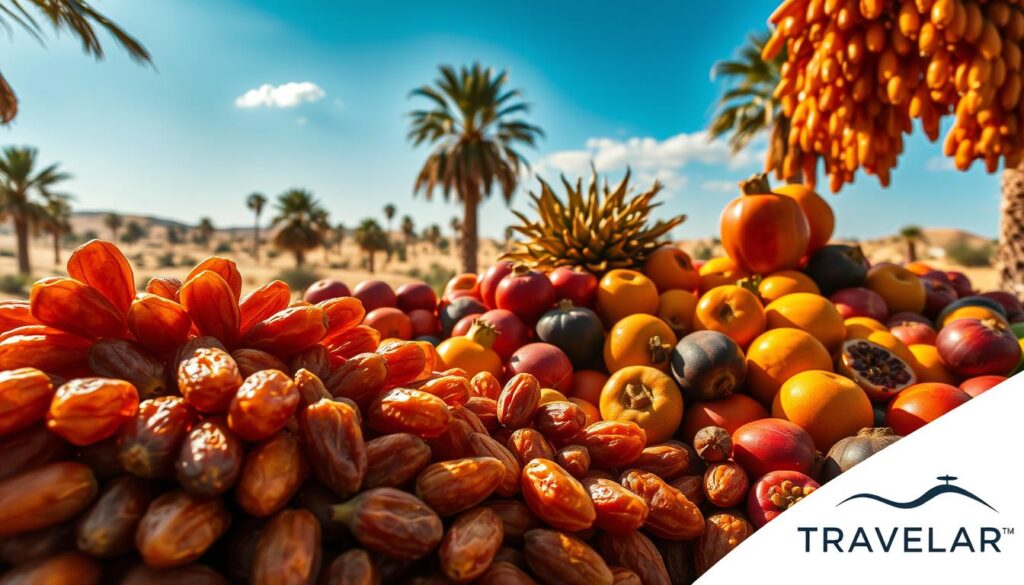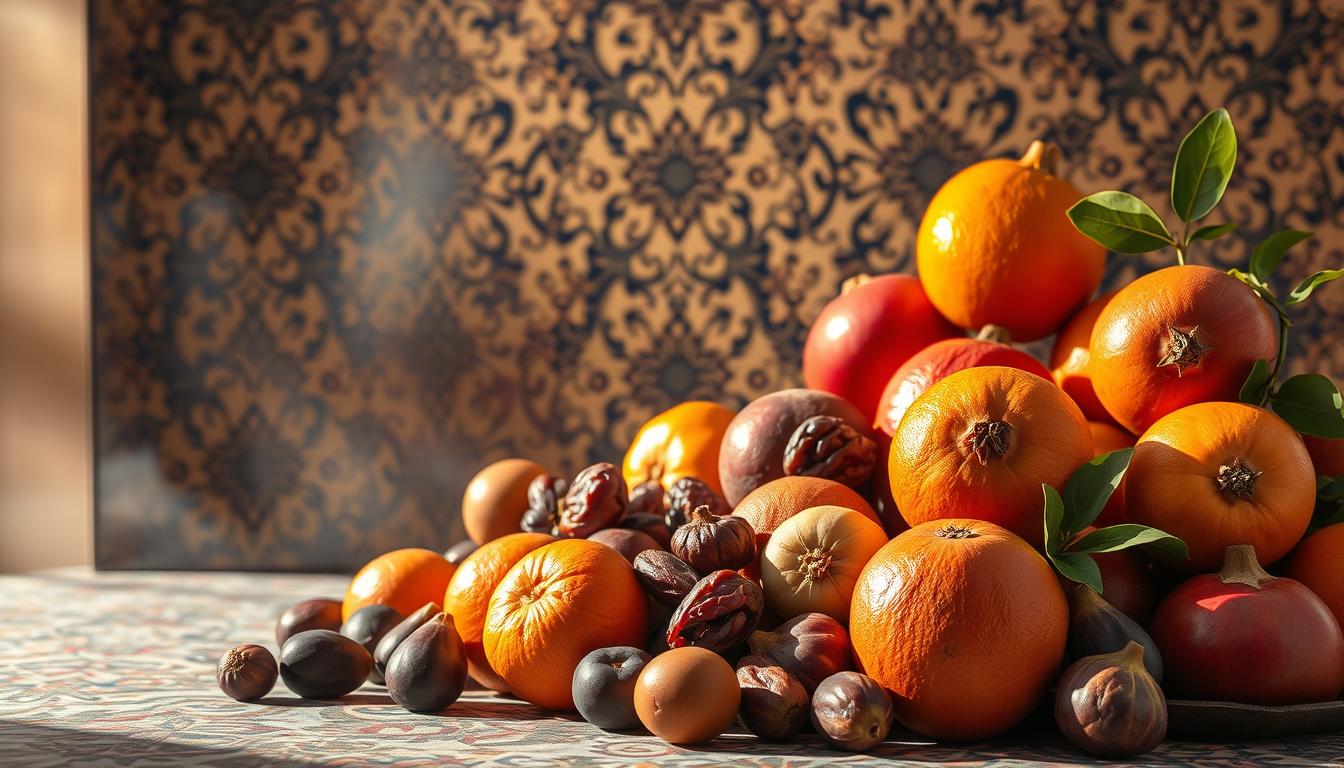Ever wondered how to connect with the Middle East’s rich culture through language? Start by learning about Fruits in Arabic, a key part of Arabic and Middle Eastern fruits. As you explore Arabic, learning fruit names is a tasty way to dive into the language and culture.
Starting your Arabic journey? Knowing how to say “fruit” in Arabic, like فاكهة (faakiha) and فواكه (fawaakih), is helpful. It lets you talk about fruits in different situations. By focusing on Arabic fruits, you’ll connect better with locals, making learning more fun and useful.
Introduction to Fruits in Arabic
Learning Arabic fruits and Middle Eastern fruits might seem hard at first. But it’s a great way to begin your language journey. With the right steps, you’ll soon know the Arabic names for common fruits. Then, you can use them in everyday talks.
Table of Contents
Introduction to Fruits in Arabic
Exploring the Arabic language opens up a world of exotic fruits and Arabic produce. These are key to Arab culture. Learning their names boosts your vocabulary and lets you enjoy the Arab culinary heritage.
This section highlights why knowing fruit names in Arabic matters. It’s good for your language skills and cultural understanding. This guide will help you explore Arabic produce and its role in Arabic cuisine.
Learning exotic fruits and Arabic produce names lets you talk better with locals. You’ll also get to appreciate their cultural value and try making Arabic dishes. So, let’s start our culinary adventure and discover Arabic produce!
Learning Arabic has many benefits:
- Deeper cultural understanding
- Better communication skills
- Access to rich literature and food heritage
This guide will teach you exotic fruits and Arabic produce names. You’ll practice speaking and find new recipes to make. Let’s dive into the world of Arabic produce together!
Common Fruits in Arabic: A Quick Overview
Exploring the Arabic fruit market reveals a wide range of fresh fruits. Each has its own name and how to say it in Arabic. The word for “fruit” is فاكهة (faakiha), and the plural is فواكه (fawaakih). Let’s start with some common fruits and their Arabic names:
Apples, bananas, and oranges are favorites in the Arabic fruit market. The Arabic for apple is تفاح (tuffah), banana is موز (mawz), and orange is برتقال (burtuqal). Grapes are called عنب (`inab), and strawberries are فراولة (farawla).
- Apples: تفاح (tuffah)
- Bananas: موز (mawz)
- Oranges: برتقال (burtuqal)
- Grapes: عنب (`inab)
- Strawberries: فراولة (farawla)
Knowing the names of these fruits in Arabic can make your visit to an Arabic fruit market better. Learning these names helps you understand the cultural importance of these fruits in Arabic cuisine and traditions.
Apples: Understanding the Arabic Name
Exploring Arabic fruit names, you’ll find apples are very common. The Arabic word for apple is تفاح (tuffah). Apples in the Arab world come in red, green, and yellow. They are a staple fruit, loved by many.
Apples are linked to health and wellness in Arabic culture. They are full of water and nutrients. This makes apples a favorite among fruit lovers. They are also great for eating, cooking, and making cider.
Some popular Arabic fruit varieties of apples include:
- Red Delicious: known for its sweet taste and crunchy texture
- Granny Smith: a green-skinned apple with a tart flavor
- Golden Delicious: a yellow-skinned apple with a sweet and mellow taste
As you explore more, you’ll see apples are just the start. There are many Arabic fruit varieties to try. Whether you want a sweet snack or a cooking ingredient, Arabic fruits have something for everyone.
Bananas: Exploring Their Arabic Name
When you look into the Arabic name for bananas, you’ll find “mawz” (موز) is often used. This term is not just in the Arab world but also in Arabic fruit images and markets. The history of bananas is interesting, with Arabs bringing them to Africa from South-East Asia centuries ago.
In different places, bananas have different names. For example, in some Spanish-speaking countries, they’re called “guineo.” In others, it’s “plátano.” The many names show how widely bananas are grown and valued. You can see bananas in many Arabic fruit images, from markets to dishes.
Exploring bananas reveals many interesting facts and uses. They play a big role in Arabic cuisine and are seen in markets. By learning about the Arabic name for bananas, you’ll appreciate their rich history and cultural importance more.
Oranges: Learning the Arabic Term
Exploring Middle Eastern fruits, you’ll find oranges play a big role in the culture. The Arabic word for orange is برتقال (burtuqal). This term shows the fruit’s rich history. Arabs introduced oranges to the Middle East from Asia, making them a key part of the region’s food and traditions.
Oranges are a staple in many Middle Eastern countries. They’re enjoyed fresh and used in dishes like salads, desserts, and juices. In Arabic culture, oranges symbolize abundance, prosperity, and good luck.
In traditional medicine, oranges are prized for their vitamin C. They’re used to treat colds, flu, and aid digestion. Oranges are not just tasty but also full of health benefits and cultural importance.
Some of the key benefits of oranges include:
- High vitamin C content
- Aid in digestion
- Boost immune system
As you explore more Exotic fruits, you’ll see oranges are just the beginning. With their history, cultural value, and health perks, oranges are sure to delight your taste buds and leave you craving more.
Grapes: The Arabic Vocabulary
Exploring Fruits in Arabic reveals grapes are loved in the Arab world. The word for grapes is عنب (inab). It’s key to know how it’s used in different ways. There are many types of grapes, each with its own traits and uses.
In Middle Eastern cultures, grapes are prized for their health benefits and cooking uses. They’re found in sweet treats and savory dishes. Research on grape quality has grown the grape industry. Countries like Brazil now produce a lot of table grapes.
Some interesting facts about grapes in the Arab world include:
- Grapes are a staple fruit in many Arabic countries, with a rich history of cultivation and trade.
- The estimated organic premiums for grapes compared to average prices of conventional produce are less than 20%.
- Brazil is the world’s fourth-largest producer of table grapes, with production volumes reaching approximately 1.75 million metric tons per season.

As you explore Arabic fruits, grapes are a big part of the cuisine and culture. Their rich flavor and health benefits make them a favorite. Learning about grapes in Arabic culture helps you understand the region’s rich heritage and traditions.
Watermelon: Arabic Name and Context
Exploring Arabic produce reveals watermelon’s popularity in the Arab world. The Arabic word for watermelon is بطيخ (batteekh). It’s known as a summer fruit, or فاكهة الصيف, in Arabic culture. Watermelon has become a symbol of solidarity with Palestine, with its colors mirroring the Palestinian flag.
In the realm of Fresh fruits in Arabic, watermelon stands out as a refreshing and nutritious choice. It’s packed with vitamins and minerals, making it excellent for a healthy diet. Its cultural significance in Arabic traditions goes beyond its nutritional benefits.
- Watermelon is a popular fruit in the Arab world, often consumed during the summer months.
- The Arabic word for watermelon, بطيخ (batteekh), is a unique term that reflects the fruit’s cultural significance.
- Watermelon has become a symbol of solidarity with Palestine, with its colors reflecting the Palestinian flag.
In conclusion, watermelon holds a significant place in Arabic culture. Its Arabic produce and Fresh fruits in Arabic context make it a favorite among those exploring Arab flavors and traditions.
Dates: The Arabic Connection
Exploring Arabic fruit varieties, you’ll find dates hold a special place. The Arabic word for dates is تمر (tamar). They’re a staple in the Arab world. With over 150 varieties in the UAE, they’re celebrated as the national fruit.
Learn more about Arabic fruit names and their significance at learn-arabic-words. This will deepen your understanding of the language and culture.
Emirati culture is deeply rooted in dates. The date palm has been a vital source of sustenance for centuries. Dates are traditionally consumed with Arabic coffee, showing a cherished cultural ritual.
Some popular varieties include Khalas, Barhi, Deglet Noor, and Medjool. Each has unique characteristics and uses in traditional Emirati dishes.
Dates are more than just a cultural symbol. They’re also rich in fiber, vitamins, and minerals. They’re often used to break fasts during Ramadan. Their nutritional value makes them a staple in many Emirati households.
The UAE is home to approximately 40 million date palms. This shows the importance of dates in the country’s economy and culture.

Dates have many benefits. They’re high in nutrition, versatile in cooking, and hold cultural significance. Here are a few reasons why dates are key in Arabic fruit varieties:
- Rich in fiber, vitamins, and minerals
- Used in traditional Emirati dishes, such as Harees
- Celebrated as the national fruit of the UAE
- Support local economies and position the UAE as a leading exporter of dates globally
As you explore Arabic fruit names and varieties, you’ll learn about dates’ cultural heritage. Their unique characteristics, nutritional value, and cultural importance make them essential to know.
Berries: Learning Their Arabic Names
Exploring the Arabic fruit market reveals a variety of berries. These are not only tasty but also nutritious. Learning their Arabic names helps you shop with confidence. You’ll find vibrant berry images online, showing their beauty and uses.
Common berries in Arabic include strawberries and grapes. Strawberries are called فراولة (farawla), and grapes are عنب (`inab). They’re delicious and full of nutrients, making them perfect for a healthy diet. The Arabic fruit market has many berries, each with its own special qualities and uses in Middle Eastern dishes.
Here are some key facts about berries in Arabic:
- Strawberries are a favorite in the Middle East, enjoyed fresh or in desserts.
- Grapes are grown widely here, used for wine, juice, and eating fresh.
- Berries are full of antioxidants, vitamins, and minerals, making them a healthy snack.
Learning Arabic names for berries can make shopping at the Arabic fruit market better. It lets you see the variety of fruits available. By exploring different berries and their uses, you’ll understand Middle Eastern cuisine better.
| Arabic Name | English Name | Description |
|---|---|---|
| فراولة (farawla) | Strawberry | A sweet and juicy fruit, often eaten fresh or used in desserts. |
| عنب (`inab) | Grape | A versatile fruit, used for wine production, juice, and fresh consumption. |
Conclusion: The Value of Fruit Names in Arabic
Exploring fruits in Arabic has shown us their importance. Knowing Arabic names for fruits can help us understand different cultures better. It’s like discovering a new world, from the sweet dates to the juicy oranges.
This guide is for anyone interested in Arabic, health, or food cultures. It gives you a solid start. Try using these names every day and look for more to learn.
Now, you’re ready to dive into the world of Middle Eastern fruits. It’s a journey filled with ancient foods and health benefits. Let’s explore and discover together.
Source Links
- Egyptian Arabic for travel to Egypt: Arabic Words and Arabic Phrases to help with your trip — Egypt Adventures Travel – https://www.egyptadventurestravel.com/blog/egyptian-arabic-for-travel-arabic-words-and-arabic-phrases
- Top 40 Arabic Food Names – Shaykhi Academy – https://shaykhi.com/blog/arabic-food-names/
- Arabic for Kids | Arab Academy – https://www.arabacademy.com/kids-arabic-courses/
- Grocery Shopping – https://nasmaofny.com/grocery-shopping/
- Top 13 Fruits In Arabic – KALIMAH – https://kalimah-center.com/fruits-in-arabic/
- Fruits & Vegetables in Levantine Arabic – https://nasmaofny.com/fruits-vegetables-in-levantine-arabic/
- No title found – https://www.sayaarab.com/fruits-in-arabic-language
- 100 Delicious Fruits Name in Arabic and English with Names – https://fruitsnamesinhindi.com/100-fruits-name-in-arabic/
- apple – https://dictionary.cambridge.org/dictionary/english-arabic/apple
- Why Are Bananas in Some Countries Called ‘Guineos’ in Spanish? – https://www.dominicancooking.com/bananas-spanish-guineo
- 30 Yummy Fruit-Inspired Baby Names For Girls And Boys – https://www.momjunction.com/articles/fruit-inspired-baby-names_00392841/
- today and in the past – https://languagelog.ldc.upenn.edu/nll/?p=47623
- Multilingualism: Empowering Individuals, Transforming Societies (MEITS) – https://www.meits.org/blog/post/orange-is-a-migrant-word
- Did Orange the Color or the Fruit Come First? – Good Blokes – https://goodblokes.nz/questions-for-dad-did-orange-the-color-or-the-fruit-come-first/
- grape – https://dictionary.cambridge.org/dictionary/english-arabic/grape
- Brazilian Table Grapes Granted China Market Access – https://www.producereport.com/article/brazilian-table-grapes-granted-china-market-access
- Views: The Watermelon Question and its Role in the Hegemonic Symbolic Erasure of Palestinian Identity – ROWAQ ARABI – https://cihrs-rowaq.org/views-the-watermelon-question-and-its-role-in-the-hegemonic-symbolic-erasure-of-palestinian-identity/?lang=en
- A Date with Tradition: Exploring the Significance of Dates in Emirati Culture – The Date Room – https://thedateroom.com/a-date-with-tradition-exploring-the-significance-of-dates-in-emirati-culture/?srsltid=AfmBOopiccB5ABd-OqoykodkkLlWB1hk4G4Zy1OuECJPRztHVzfumMEy
- National Fruit of UAE: The Cultural Significance of Dates – https://anysqft.ae/culinary-traditions/national-fruit-of-uae/
- What are The Most Popular Dates of Arabia? – https://originz.co/organically-speaking/most-popular-types-of-dates-of-arab
- Orange (fruit) – https://en.wikipedia.org/wiki/Orange_(fruit)

